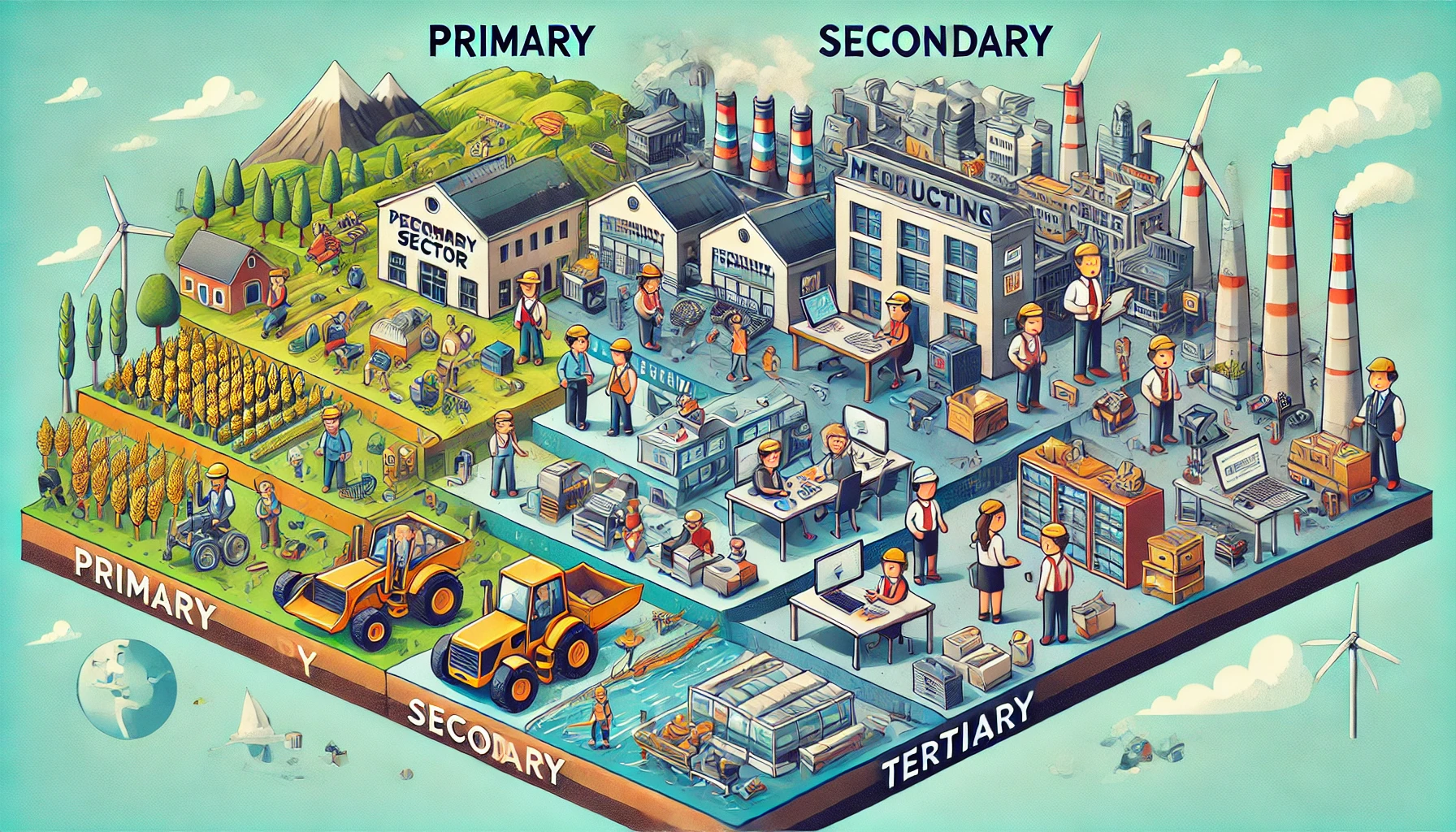The economy is commonly divided into three main sectors: primary, secondary, and tertiary. Each sector represents a distinct area of economic activity and contributes differently to the overall economy.
1. Primary Sector
The primary sector involves the extraction and harvesting of natural resources from the earth. It includes industries that engage in activities such as agriculture, mining, forestry, and fishing.
Key Characteristics:
- Resource-Based: The primary sector relies on natural resources, either renewable (like crops and fish) or non-renewable (like minerals and fossil fuels).
- Foundation of Economy: It is often considered the foundation of an economy, especially in developing countries where a significant portion of the workforce is employed in this sector.
- Labor-Intensive: Many primary sector activities are labor-intensive, though technological advancements are gradually increasing mechanization and efficiency.
Examples of Primary Sector Activities:
- Agriculture: Cultivation of crops, livestock farming, dairy farming.
- Mining: Extraction of minerals, coal, oil, and natural gas.
- Forestry: Logging, timber production, and managing forest resources.
- Fishing: Commercial fishing, aquaculture, and seafood harvesting.

2. Secondary Sector
The secondary sector encompasses industries that process raw materials from the primary sector into finished goods and products. This sector is synonymous with manufacturing and construction.
Key Characteristics:
- Value Addition: The secondary sector adds value to raw materials by transforming them into more complex products that are useful and consumable.
- Industrial Base: It forms the industrial base of an economy, producing goods for consumption and export.
- Capital-Intensive: Activities in the secondary sector often require significant capital investment in machinery, equipment, and technology.
Examples of Secondary Sector Activities:
- Manufacturing: Production of goods such as automobiles, electronics, machinery, textiles, and chemicals.
- Construction: Building infrastructure like roads, bridges, buildings, and other physical structures.
- Processing: Food processing, metal refining, and production of consumer goods.

3. Tertiary Sector
The tertiary sector involves the provision of services rather than goods. It is also known as the service sector and includes a wide range of activities that support other sectors and meet the needs of consumers.
Key Characteristics:
- Service-Oriented: This sector focuses on providing intangible goods such as services and experiences rather than physical products.
- Economic Dominance: In many developed economies, the tertiary sector is the largest sector, both in terms of GDP contribution and employment.
- Diverse Activities: The sector includes various industries such as finance, healthcare, education, retail, and entertainment.
Examples of Tertiary Sector Activities:
- Healthcare: Hospitals, clinics, and other medical services.
- Education: Schools, colleges, universities, and training institutions.
- Financial Services: Banking, insurance, investment services, and real estate.
- Retail and Wholesale: Stores, supermarkets, and wholesale businesses.
- Transportation and Communication: Public transport, logistics, telecommunications, and internet services.
- Hospitality and Tourism: Hotels, restaurants, travel agencies, and tourism services.
- Information Technology and Software Services: IT consulting, software development, and online services.

Interdependence of Sectors:
- Supply Chain Integration: The three sectors are interconnected through supply chains. The primary sector provides raw materials to the secondary sector, which manufactures goods. The tertiary sector offers services that support both the primary and secondary sectors, such as transportation, distribution, and sales.
- Economic Development: As economies develop, they often transition from a focus on the primary sector to the secondary and eventually to the tertiary sector. This shift is associated with industrialization, urbanization, and increased income levels.

Understanding the three sectors of the economy is essential for analyzing economic structure and growth. The primary sector focuses on raw materials, the secondary sector on manufacturing and construction, and the tertiary sector on services. Each sector plays a crucial role in the overall economy, contributing to GDP, employment, and societal development. The balance and evolution of these sectors reflect the level of economic development and diversification in a country.

